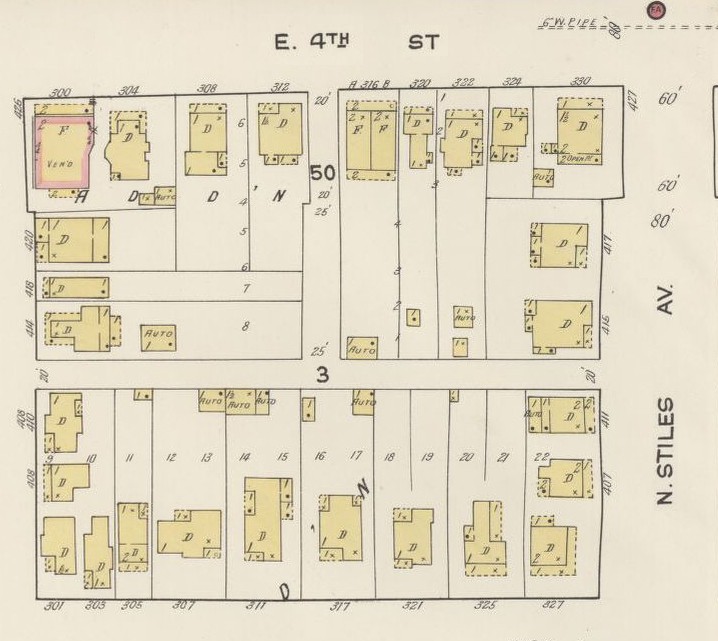Ellison Family Home (1926) -- 415 East Stiles
Introduction
Text-to-speech Audio
In July, 1924, Ralph Ellison's widowed mother Ida married James Ammons who became stepfather to Ralph. For a time, Ammons brought stability to young Ralph's otherwise unsettled childhood. However when Ammons died unexpectedly two years later, the family was once again thrown into poverty and Ida and the Ellison boys moved here in 1926.
Images
Map Detail of 415 N Stiles, Sanborn Fire Insurance Map from Oklahoma City, Oklahoma County, Oklahoma

Backstory and Context
Text-to-speech Audio
Although Ellison never explicitly wrote of his stepfather, James Ammons, his relationship with him was not contentious and Ammons taught the young teenager Ralph how to track and hunt small game. This skill for an urban boy like Ralph was useful in many respects, one being to feed the fuel for what is believed to be Ellison’s first novel, the manuscript Slick (1939), whose protagonist tells fond tales of his youth in Oklahoma hunting game in Oklahoma with his out-of-work stepfather. After Ammons' untimely death, the Ellisons were forced to return to their nomadic existence, landing in one small room at 415 East Stiles. The home was owned by Cyril and Edna House. Cyril was a porter for the National Cash Register Company. Ellison’s mother returned to “Mrs. Ida Ellison.” Despite the cramped quarters on East Stiles, or perhaps because of them, Ellison took his trumpet playing to a new level, practicing for hours on his horn. As he later wrote, “Caught mid-range between my two traditions [classical and jazz]…I caused whole blocks of people to suffer. Indeed, I terrorized a good part of an entire city section. During summer vacation I blew sustained tones out of the window for hours, usually starting–especially on Sunday mornings–before breakfast. I sputtered whole days through…double-and triple-tonguing exercises with an effect like- that of a jackass hiccupping off a big meal of briars. During school-term mornings I practiced a truly exhibitionist ‘Reveille’ before leaving for school, and in the evening I generously gave the ever listening world a low, slow version of ‘Taps,’ ineptly played but throbbing with what in my adolescent vagueness felt was a romantic sadness. For it was farewell to day and a love song to life and a peace-be-with-you to all the dead and dying…Sometimes, inspired by the even then considerable virtuosity of …Charlie Christian (who during our school days played marvelous riffs on a cigar-box banjo), I’d give whole summer afternoons and the evening hours after heavy suppers of Black-eyed peas and turnip greens, cracklin’ bread and buttermilk, lemonade and sweet potato cobbler, to practicing hard-driving blues. Such food oversupplied me with bursting energy, and from listening to Ma Rainey, Ida Cox and Clara Smith, who made regular appearance in our town, I knew exactly how I wanted my horn to sound…Despite those who complained and cried to heaven for Gabriel to blow a chorus so heavenly sweet and so hellishly hot that I’d forever put down my horn, there were more tolerant ones who were willing to pay in present pain for future pride. For who knew what skinny kid with his chops wrapped around a trumpet mouthpiece and a faraway look in his eyes might become the next Armstrong.”
Sources
Ellison, Ralph. Living with Music. New York City, New York. The Modern Library, 2001.
Graham, Maryemma. Singh, Amiritjit. Conversations with Ralph Ellison. Jackson, Mississippi. University of Mississippi Press, 1995.
Jackson, Lawrence. Ralph Ellison: The Emergence of Genius. New York City, New York. John Wiley & Sons, Inc., 2002.
https://www.loc.gov/resource/g4024om.g4024om_g07202192201/?sp=30&r=0.245,0.024,1.055,0.593,0
